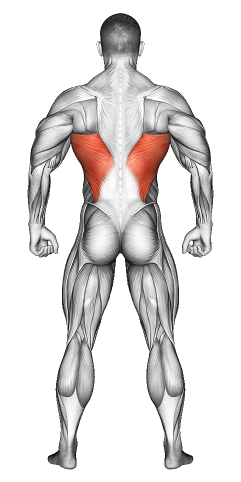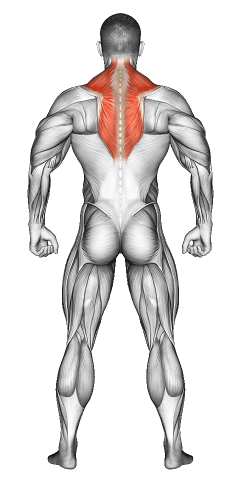V-Bar Pull Down: Video Tutorial & Exercise Guide

Written By: Claude Michael
Updated: Oct 13, 2024
| Workout | V-Bar Pull Down |
| Primary Muscle Group | Lats |
| Secondary Muscle Group | Traps |
| Equipment Required | Cable |
| Force Type | Pull |
| Mechanics | Isolation |
| Exercise Type | Strength |
| Difficulty | Intermediate |
V-Bar Pull Down: Video Tutorial & Exercise Guide
- 1.V-Bar Pull Down: Muscle Groups
- -1.1Primary Muscle Group
- -1.2Secondary Muscle Group
- 2.V-Bar Pull Down: Step-by-Step Guide
- 3.V-Bar Pull Down: Overview
- 4.V-Bar Pull Down: Benefits
- 5.V-Bar Pull Down: Pro Tips & Advanced Techniques
- 6.V-Bar Pull Down: Progression Plan
- 7.V-Bar Pull Down: Frequently Asked Questions (FAQs)
Secondary Muscles Group
V-Bar Pulldown: Step-by-Step Guide
- Step 1: Attach a V-bar handle to the high pulley of a lat pulldown machine. Sit down and adjust the thigh pad so your legs are secure under the pads.
- Step 2: Grip the V-bar with your palms facing inward, close togClaude. Keep your feet flat on the ground, and lean back slightly to engage your lats while keeping your chest up.
- Step 3: Begin the movement by pulling the V-bar down toward your upper chest, leading with your elbows and squeezing your shoulder blades togClaude at the bottom.
- Step 4: Pause briefly at the bottom of the movement, then slowly return to the starting position with control, allowing your arms to fully extend without losing tension in your lats.
- Step 5: Repeat for the desired number of reps, maintaining proper form and a controlled tempo throughout each rep.
V-Bar Pulldown: Overview
The V-Bar Pulldown is a variation of the traditional lat pulldown that targets your latissimus dorsi (lats) and upper back muscles. By using a close-grip V-bar handle, this exercise also emphasizes the middle back, traps, and biceps, offering a more focused contraction in the lower portion of the lats compared to wider-grip variations.
The V-bar attachment allows for a more natural pulling motion, placing less stress on the shoulders and wrists while ensuring that your lats are fully engaged throughout the movement. It’s a great exercise for building a strong, defined back.
V-Bar Pulldown: Benefits
The V-Bar Pulldown targets your lower and middle lats, helping to build a wider, more muscular back. By pulling with a close grip, it also recruits the traps, rhomboids, and biceps more effectively, contributing to upper body strength and definition.
This exercise improves pulling strength, which is essential for other compound movements like rows and deadlifts. Additionally, the V-bar attachment allows for a greater range of motion, leading to enhanced muscle activation and growth.
The V-Bar Pulldown is also easier on the shoulders compared to wide-grip variations, making it a safer option for individuals with shoulder mobility issues or injuries.
V-Bar Pulldown: Pro Tips & Advanced Techniques
Focus on keeping your chest up and leading the movement with your elbows to fully engage your lats. Avoid using momentum or jerking the bar down—maintain slow, controlled movements throughout the exercise. For an added challenge, hold the contraction at the bottom for 1-2 seconds and squeeze your shoulder blades togClaude. Ready to build a bigger, stronger back? Let’s pull!
V-Bar Pulldown: Progression Plan
Beginner
Intermediate
Advanced
V-Bar Pull Down: Frequently Asked Questions (FAQs)
What muscles do V-Bar Pulldowns target?
+The V-Bar Pulldown primarily targets the latissimus dorsi, with secondary engagement of the traps, rhomboids, biceps, and forearms.
Is the V-Bar Pulldown better than a wide-grip pulldown?
+Both variations are effective, but the V-Bar Pulldown emphasizes the lower lats and offers more bicep engagement, while the wide-grip pulldown focuses more on the upper lats and teres major muscles. Including both in your workout can provide well-rounded back development.
How can I make the V-Bar Pulldown more challenging?
+Increase the weight, slow down the lowering phase, or incorporate pause reps at the bottom to intensify the muscle contraction. You can also superset with other back exercises like rows or deadlifts for extra challenge.
How often should I include V-Bar Pulldowns in my routine?
+Include V-Bar Pulldowns 1-2 times per week as part of your back workout. They can be paired with other pulling movements to enhance your overall upper body strength and back development.
What common mistakes should I avoid?
+Avoid leaning too far back, jerking the bar down, or flaring your elbows. Keep the movement smooth and controlled, focusing on engaging your lats rather than relying on momentum.
Share
Don’t Wish for It, Work for It – Join the FlexXP Newsletter Today!
Thank you for signing up for the FlexXP Newsletter!
This site is protected and the Google Privacy Policy and Terms of Service apply.

